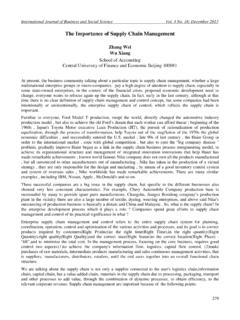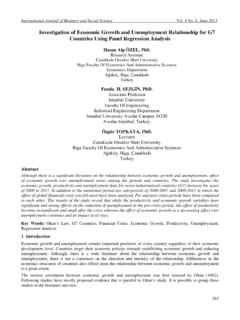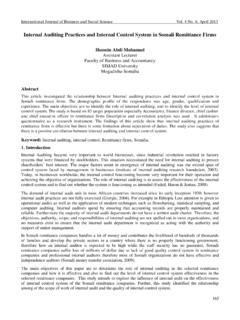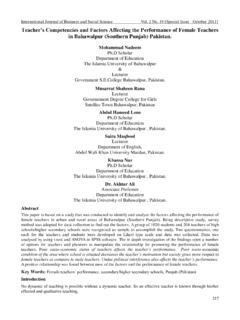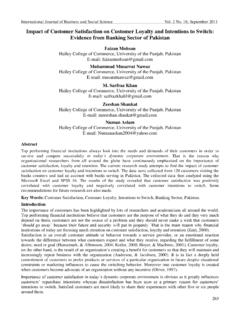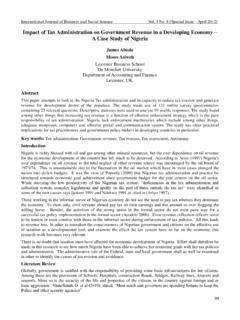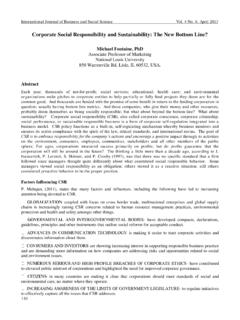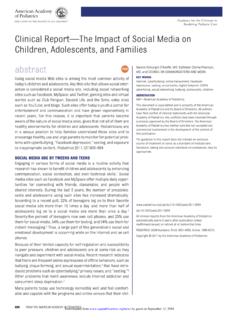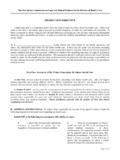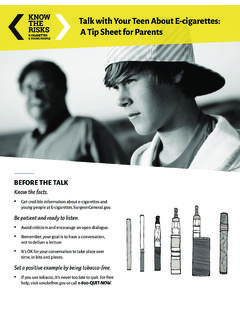Transcription of Marketing to Teenagers: The influence of Color, Ethnicity ...
1 International Journal of Business and Social Science Vol. 3 No. 22 [Special Issue November 2012]. Marketing to Teenagers: The influence of Color, Ethnicity and Gender Okan Akcay, Professor of Marketing Department of Business Administration College of Business, DF # 217. Kutztown University Kutztown, Pennsylvania, 19530, USA. Abstract Teenagers currently make up about 10% of the population and have strong buying power. They are the most multi-culturally diverse group of consumers. The teenager population is growing at twice the rate of the overall population and the rate of growth for Hispanic teens is three times the rate for non-Hispanics. These numbers represent incredible opportunity for marketers who must understand what drives teenagers purchasing decisions. Color is believed to be an important feature and characteristic that influences teen's product choices. This research shows that there is a difference in color choices for various products based on teen's gender and or Ethnicity .
2 For Marketing to teens to be most effective, companies must be clear about who their target market is and tailor their products with respect to color. Keywords: Marketing , Teenagers, Consumer Behavior, Product Color Choice, Ethnic Groups. 1. Introduction The teenage market has become a very important consumer segment in the and global markets (Kotler and Keller, 2011). The teenage population is growing at twicethe rate of the overall population. The number of American teenagers is over 32 million (Cohen, 2009). Globally, the number of teenagers is billion (Keegan and Green, 2013).The Hispanic teen age rate is growing at three timesthe rate of non-Hispanic teens. According to the 2010 Census Bureau, one third of Hispanics are younger than 18, compared to one fifth of non- Hispanics. The 12 to 19 year old age group is moreethnically diverse than any other generation in history. The majority of teens are Hispanic, African American and Caucasian with a growth rate forteens of 17%over the past ten years.
3 Roughly 15% of the 12 to 19year old population are African American, 16% Hispanic and 4% are Asian American; the remaining two-thirds are Hispanic teen population will be the fastest growing segment of population by 2020and is expected to be about 8 million strong (U S Census; D'Souza, 2010; The Nielsen Company, 2012). 2. Marketing to Teenagers Teenagers spend their free time doing a variety of activities including shopping online, using social media, technology, listening to music, participating in community activities, sports and watching TV. They appreciate current fashion, art, cultural and environmental efforts (Carter, 2011). The basic rules for Marketing to teenagers are: to be authentic, honest, create a buzz about the company's product, offer cool products, keep your message simple, don't talk down to them, learn their language, offer something that they can use, engage with and solicit feedback from teenage customers (Schiff, 2007;Goodstein, 2007).
4 Teens are realisticand quick to adopt new trends, and both male and female teenagers spend most of their money on clothes (D'Souza, 2010). According to one study, Hispanic teens resemble the general population of teens in many aspects, such as media consumption, internet usage, pop culture, music, past-times, brand ratings, role models and future plans. Their aspirations are nearly identical: they want to graduate from high school, go to and graduate from college. Teenagers look toward to the future, are ambitious, opinionated, influential, and know more about technology than previous generations (Chaet, 2012). They spend more time on the internet, playing video games, social networking and surfing the web. Teenagers have significant buying power. 10. The Special Issue on Arts, Commerce and Social Science Centre for Promoting Ideas, USA The average annual income of a 15-17 year old is $4,023; and total spending on products bought by and for teens is $ Billion (Davis, 2011; D'Souza, 2010; ).
5 Marketers should understand teen purchasing behavior and what influences their purchasing decisions. Teens often have more discretionary income than adults who have mortgages, car payments and other necessary spending. Older teens spend their own money on clothes, jewelry, sports, entertainment, food, health and beauty productsfor a total $ billion spent in annual amount of money families spend on teens for food, apparel, personal-care items, and entertainment is $ billion ( ). Teen's spending money is accumulated through paying jobs, allowances, or monetary teens say that the internet has changed the way they spend their free time and they haveintegrated technology into their lives (Helmrich, 2004). One out of three view the internet as their primary source of entertainment and 90% use a computer either at home or at school. Most teenagers shop in shopping malls/centers, discount stores, drugstores, electronic stores and department stores (Davis, 2011).
6 According toNielsen, teenagers average daily media consumption is widely different from any other group of consumers. They spend an average 200 minutes watching television, 52 minutes on a computer,25 minutes playing video games and even more time talking on the phone and exchanging about 96 text messages per day. Marketers reach teenagers in many different ways, mostly through electronic mass mediasuch as: TV, radio, magazines and product placement (Davis, 2011; Carter, 2011). 3. Literature Review The teenage market is growing in the It is important to market to teens because of their large discretionary income and ability to purchase luxury items. The teen market has many opportunities for marketers, but there are also many challenges involved in the Marketing process (Chaet, 2012). Their buying power is huge because most of their money is spent directly on themselves, as they usually do not have many financial responsibilities.
7 But recent unemployment rates among teenagers have been increasing and have impacted their buying power. Teens tend to spend their money on clothes, food and candy, soft drinks and recorded music. They influence household spending of big and small purchases. Older teens have more influence on personal computers, cell phones and personal care products. Magazines have a huge influence on teenager's lives. They are bombarded with advertisements and they trust magazine advertising more than other teens consider themselves to be brand loyal and have an emotional connection with products (Carter, 2011). The products they feel a brand name is most important for are: computers, shoes, MP3 players, cell phone service and clothes. Some of their favorite brands are: Apple, American Eagle Outfitters, Face book and Abercrombie & Fitch (Hoffmann, 2012). Apple was able to expand its market share among teenagers;iPhone adaptation hit 40% and iPad 31% recently in the (Campbell, 2012).
8 There are many recommendations that marketers should pay attention to when they are trying to get teen's interest and awareness about their products and services. The most important are: enlisting social media (face book, MySpace and Twitter), knowing the audience and their parents influence . When advertising to teens, there are many strategies a marketer can utilize such as continuously updating advertisements, using catchy music, sexuality and comedy to attract them (Gill, 2012).One survey found that teenagers love Apple products, use them and intend to purchase them in the future (Golijan, 2012). Apple has proven to be one of the best marketers to teenagers through their many different campaigns and is at the top of teen's favorite brands. The company not only meets a need but also has good product design. They keep Marketing simple-letting the press and fans fill in the gaps with buzz Marketing (Schiff, 2007).
9 Marketers should focus on learning more about teenagers, not only from demographic and behavioral perspectives, but specifically about drivers of their attitudes. This level of insight will allow marketers to understand unmet needs and develop brands and store concepts that appeal to teenage consumers. In many ways male and female teens appear to have similar interests, desires and consumption behaviors (Schiffman, et al., 2010). Both genders shop and spend a significant amount of their time browsing malls and are influenced by friends, family and celebrities. Before they go to a mall, teens browse assortment, verify availability and check prices on line. Male teen shoppers are believed to buy brand; while female teens tend to buy style. Females prefer softer colors and males prefer brighter colors. Females are more likely than males to have favorite color (Khouw, 2003).Thereis a significant difference in spending habits between genders.
10 According to a recent study, female teenagers bought twice as much as clothingas male teens. Male teenagers bought three times more video games than female. African Americansspend 6% more than average teenagers on clothing, computer software, athletic footwear, and music (Davis, 2011). 11. International Journal of Business and Social Science Vol. 3 No. 22 [Special Issue November 2012]. Color has strong influence on visual attributes, recognition, attention and identification of objects (Wichmann, et al., 2002).Product color has affected consumer product choice (Clarke and Honeycutt, 2000) and brand image. It can create a positive or negative image about products (Grossman and Wisenblit, 1999; Singh, 2006).People of differentage, gender and Ethnicity perceive color differently (Silver, 1998; Crozier, 1996; Jemason, 2005;. Boyatzis and Varghese, 1994, Krishna, 1972; Choungourian, 1968).

